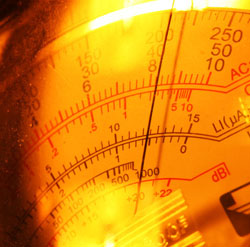
R Vs. X
The reason we need to draw a distinction between resistance and reactance is that reactance changes based on the frequency applied to the circuit. This makes sense: Reactance is the circuit’s response to alternations in the current direction, so it follows that changing the speed of these alternations would affect the reactance.
In terms of electricity, such as in the case of our light bulb, this is a moot point since North American power is always distributed at 60 Hz, so reactance is a one-and-done calculation. This is how electricians use the blanket term of “resistance” though they’re technically describing impedance. For them, frequency is a constant and therefore so it reactance.
(Note, though, that even at 60 Hz there are still resistive and reactive properties that must be considered. A load can be purely resistive, purely reactive, or a combination. This is accounted for by the power factor, and many modern amplifier employ power factor correction to improve their efficiency.)
When it comes to audio signals, the situation is much more complex: our frequencies vary from 20 Hz to 20 kHz, three orders of magnitude. The huge frequency range means that our circuits will react far differently at 20 Hz than they will at 20 kHz. I won’t impede you with my formulas (ha!) but the calculation of XL and XC incorporate a frequency variable, Ƒ, without which it’s impossible to do the calculation. It’s therefore impossible to discuss the behavior of a reactive circuit unless we consider frequency.
The formula for capacitive reactance (XC) is a fraction with the f in the denominator. As frequency increases, XC become smaller – less and less opposition. Inserting a 79 µƑ (microfarad) capacitor into an AC circuit creates 100 ohms of reactance at 20 Hz, 2 ohms at 1 kHz, and .1 ohms at 20 kHz. Increasingly high frequencies pass more easily, and increasingly low frequencies are impeded, so capacitance creates a simple high-pass filter.
The formula for inductive reactance (XL) has the Ƒ in the numerator, so XL increases with frequency. A 318 µH (microHenry) inductor causes .04 ohm of reactance at 20 Hz, 2 ohms at 1 kHz and 40 ohms at 20 kHz. Increasingly low frequencies pass more easily, and highs are increasingly blocked, so inductance creates a simple low-pass filter. (If you design filters, you know that 318 MµH is a strange value for an inductor, but the resulting figures clearly illustrate the change in response over frequency).
It’s easy to see that impedance varies with frequency. This isn’t what most people think of when they hear the term “impedance” but it’s at the heart of how equalizers and crossover networks function, so it’s vital to understand.
Let’s return again to our light bulb example, and this time let’s run the AC at a frequency of 120 Hz. Since the light bulb filament is inductive, it would present a higher impedance to their higher frequency, and the bulb would be dimmer.
Through a pure inductor, doubling Ƒ also doubles XL and thus passes half the voltage. “Half the voltage” is -6 dB, which is why a simple single-pole crossover filter has a slope of 6 dB/octave. (Remember, an octave is doubling of frequency). To create steeper slopes, we cascade reactive elements. A 24 dB/octave filter circuit has four reactive elements that contribute 6 dB/octave each.
If impedance varies with frequency, why so do we have loudspeakers labeled “Impedance: 8 ohms”? The truth is that the Z rating on most loudspeakers is a worst-case scenario. Many loudspeakers have impedance curves that look like roller coasters. We usually want to know the worst-case rating – the lowest point on the curve – because this tells us the most load that the loudspeaker could place on the amp.
Remember, lower Zs translate into higher loads on the amp since there’s less to oppose the flow of current. So an 8-ohm-rated loudspeaker probably exhibits a much higher impedance throughout most of its frequency range. The rated impedance is always higher than the lowest point on the curve. The IEC standard says that the rated impedance cannot be higher than the low point * 1.2. So, an 8 ohm loudspeaker could have a Zmin closer to 5 ohms.
Very low impedances are undesirable because the amp is approaching a short-circuit (0 ohms). In the sub-2-ohm range we have to deal with a whole slew of unpleasantries, including decreased amplifier lifespan, increased distortion, higher current draw, overheating, smoke, fire, and loss of employment.
In the next article, I’ll further these concepts and offer additional practical examples.
Jonah Altrove is a veteran live audio professional on a constant quest to discover more about the craft.
